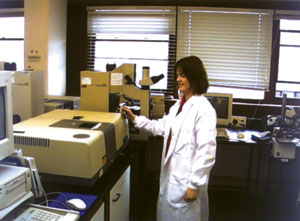| 2003 |

|
YEAR BOOK |
The Forensic Science Laboratory
|
Has Crack Cocaine hit Irish Streets?
|

Cocaine abuse has attracted significant public concern for two reasons. Firstly cocaine has never been so widely available. This is reflected in the number of cocaine cases received into the laboratory (411 in 2002 compared to 163 in 1997). Secondly there is a concern that "crack" cocaine may be appearing on Irish streets. "Crack" cocaine is produced by treatment of cocaine-hydrochloride (salt form) with an alkaline solution or powder such as baking soda. It is more volatile than cocaine-hydrochloride and may be smoked. "Crack" cocaine poses a greater risk to users as its effects are more rapid and intense than those of cocaine salt and there is a tendency to develop dependence in a shorter period of time. This can have serious implications for the levels of crime associated with cocaine abuse.
For these reasons, the extent and type of cocaine abuse in Ireland has been highlighted for close monitoring under the National Drugs Strategy. This year the Forensic Science Laboratory, in conjunction with the Garda National Drugs Unit, has undertaken a project to screen cocaine seizures for the presence of "crack" cocaine. The screening is performed in two steps: 1. A sample of cocaine is tested with cobalt thiocyanate solution, where the possible presence of "crack" is indicated by the formation of a blue insoluble complex. 2. A sample is prepared in a potassium bromide (KBr) disc for Fourier Transform Infrared Spectrometry analysis (FTIR). The presence of the chloride ion in the salt form alters the absorption pattern of the cocaine molecule in FTIR, allowing the two forms of cocaine to be distinguished. A third method involving the use of gas chromatography mass spectrometry (GCMS) to identify low quantities of "crack" cocaine in mixtures of cocaine-hydrochloride and adulterants is under investigation by the laboratory. Of 122 cases screened to date four have been found to contain "crack" cocaine. This indicates that "crack" cocaine represents a very small percentage of Irish street cocaine.
Contact: Dr Elaine Raggett; E-mail: [email protected]